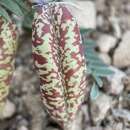Comprehensive Description
provided by North American Flora
Phaca oophora (S. Wats.) Rydberg
Astragalus oophorus S. Wats. Bot. King's Expl. 73. 1871. Tragacanlha oophora Kuntze, Rev. Gen. 947. 1891.
Perennial, somewhat cespitose; stems 3-5 dm. high, glabrous, striate, decumbent at the base; leaves 5-10 cm. long; stipules deltoid, distinct, acuminate, about 5 mm. long; leaflets 9-17, oblong-elliptic, 15-20 mm. long, 4-7 mm. wide, minutely mucronate, glabrous; peduncles about 5 cm. long; racemes short, 61 0-flowered ; calyx-tube campanulate, 5 mm. long, glabrous, the lobes subulate, 4 mm. long; corolla ochroleucous, 15 mm. long; banner obovate, gradually tapering below; wings somewhat shorter, the blade oblong-lunate, about equaling the claw, with a rounded basal auricle; keel-petals similar but broadei and rounded at the apex; pod glabrous, the stipe 5 mm. long, the body ellipsoid, 4-5 cm. long, 2-2.5 cm. wide, mottled (?).
ypE locality: Reese River Pass of the Shoshone Mountains, Nevada.
istribution: Eastern Nevada.
- bibliographic citation
- Per Axel Rydberg. 1919. (ROSALES); FABACEAE; PSORALEAE. North American flora. vol 24(1). New York Botanical Garden, New York, NY
Comprehensive Description
provided by North American Flora
Phaca jucunda Jcpson & Rydberg, sp. nov
Perennial, with a cespitose caudex; stems decumbent at the base, glabrous, 2—4 dm. high, striate; leaves ascending, 10-15 cm. long, the rachis glabrous; stipules broadly deltoid, 5-8 mm. long; leaflets 11-19, broadly oval or obovate, mostly retuse at the apex, glabrous on both sides, 5-20 mm. long, 4-10 mm. wide; peduncles 7-15 cm. long, glabrous; racemes 3-7 cm. long; bracts subulate, 3 mm. long, nearly equaling the pedicels; calyx glabrous, the tube campanulate, 5 mm. long, the lobes lance-subulate, 4 mm. long; corolla purple, at least the banner; banner obovate, 15-18 mm. long, moderately arcuate; wings 13-15 mm. long, the blade oblanceolate, fully as long as the claw, rounded at the apex, with a large reflexed auricle; keel-petals 12-13 mm. long, the blade broadly lunate, rounded at the apex; pod ellipsoid, more or less mottled, about 4 cm. long and 2 cm. wide, acutish at each end, the stipe a little exceeding the calyxtube.
Type collected on Telescope Peak, Panamint Mountains, California, 1917, W. L. Jcpson. Distribution: Eastern California and western Nevada.
- bibliographic citation
- Per Axel Rydberg. 1919. (ROSALES); FABACEAE; PSORALEAE. North American flora. vol 24(1). New York Botanical Garden, New York, NY
Physical Description
provided by USDA PLANTS text
Perennial, Herbs, Stems woody below, or from woody crown or caudex, Taproot present, Nodules present, Stems or branches arching, spreading or decumbent, Stems less than 1 m tall, Stems solid, Stems or young twigs glabrous or sparsely glabrate, Stems or young twigs sparsely to densely hairy, Leaves alternate, Leaves petiolate, Stipules conspicuous, Stipules membranous or chartaceous, Stipules persistent, Stipules free, Stipules clasping stem at the base, Leaves compound, Leaves odd pinnate, Leaf or leaflet margins entire, Leaflets opposite, Leaflets 10-many, Leaves hairy on one or both surfaces, Inflorescences racemes, Inflorescence axillary, Bracts very small, absent or caducous, Flowers zygomorphic, Calyx 5-lobed, Calyx glabrous, Calyx hairy, Petals separate, Corolla papilionaceous, Petals clawed, Petals ochroleucous, cream colored, Petals orange or yellow, Banner petal narrow or oblanceolate, Wing petals narrow, oblanceolate to oblong, Wing tips obtuse or rounded, Keel petals auriculate, spurred, or gibbous, Keel tips obtuse or rounded, not beaked, Stamens 9-10, Stamens diadelphous, 9 united, 1 free, Filaments glabrous, Style terete, Style persistent in fruit, Fruit a legume, Fruit stipitate, Fruit unilocular, Fruit humistrate, lying on the ground, Fruit tardily or weakly dehiscent, Fruit oblong or ellipsoidal, Fruit exserted from calyx, Fruit inflated or turgid, Fruit beaked, Fruit glabrous or glabrate, Fruit 11-many seeded, Seeds cordiform, mit-shaped, notched at one end, Seed surface smooth, Seeds olive, brown, or black.
Astragalus oophorus: Brief Summary
provided by wikipedia EN
Astragalus oophorus is a species of milkvetch known by the common name egg milkvetch. It is native to the western United States, mainly California and Nevada, though one variety can be found as far east as Colorado. It is a plant of sagebrush and other dry habitat.
- license
- cc-by-sa-3.0
- copyright
- Wikipedia authors and editors

